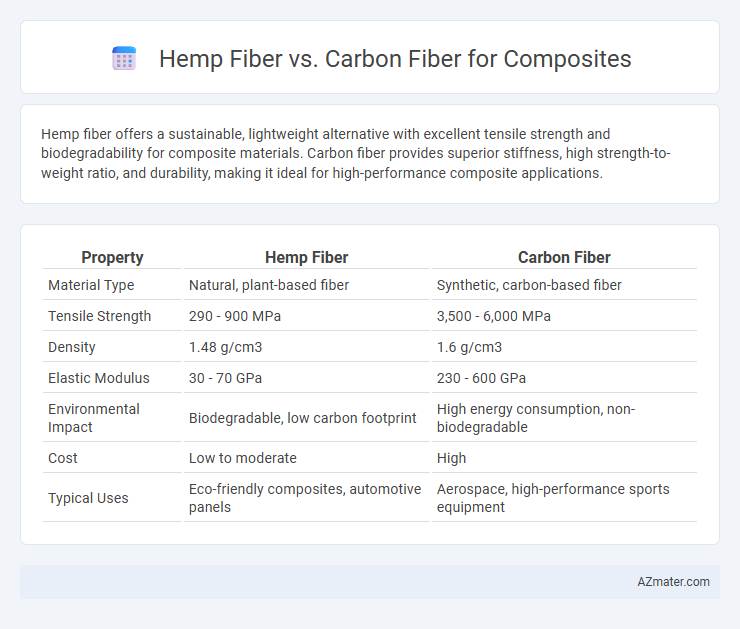Hemp fiber offers a sustainable, lightweight alternative with excellent tensile strength and biodegradability for composite materials. Carbon fiber provides superior stiffness, high strength-to-weight ratio, and durability, making it ideal for high-performance composite applications.
Table of Comparison
| Property | Hemp Fiber | Carbon Fiber |
|---|---|---|
| Material Type | Natural, plant-based fiber | Synthetic, carbon-based fiber |
| Tensile Strength | 290 - 900 MPa | 3,500 - 6,000 MPa |
| Density | 1.48 g/cm3 | 1.6 g/cm3 |
| Elastic Modulus | 30 - 70 GPa | 230 - 600 GPa |
| Environmental Impact | Biodegradable, low carbon footprint | High energy consumption, non-biodegradable |
| Cost | Low to moderate | High |
| Typical Uses | Eco-friendly composites, automotive panels | Aerospace, high-performance sports equipment |
Introduction to Hemp Fiber and Carbon Fiber Composites
Hemp fiber composites offer sustainable, biodegradable alternatives with high tensile strength and excellent impact resistance, making them suitable for eco-friendly applications. Carbon fiber composites, characterized by low density and exceptional stiffness, provide superior strength-to-weight ratios essential in aerospace, automotive, and high-performance sports equipment. Comparing mechanical properties, hemp fiber composites exhibit moderate strength and lower cost, whereas carbon fiber composites deliver unmatched durability and conductivity for advanced engineering uses.
Material Composition and Structure Comparison
Hemp fiber, derived from the stalks of the Cannabis sativa plant, consists primarily of cellulose, hemicellulose, and lignin, providing a natural, biodegradable structure with moderate tensile strength and flexibility. Carbon fiber is composed of thin strands of carbon atoms bonded in a crystalline formation, resulting in a high-strength, lightweight material with exceptional stiffness and thermal stability. In composite applications, hemp fiber offers eco-friendly benefits and impact resistance, whereas carbon fiber excels in mechanical performance and durability due to its densely packed atomic structure and alignment.
Mechanical Properties: Strength and Durability
Hemp fiber composites exhibit moderate tensile strength and excellent impact resistance, offering enhanced durability in fatigue-prone applications, making them a sustainable alternative for lightweight structures. Carbon fiber composites deliver superior tensile strength and stiffness, with exceptional fatigue resistance and minimal deformation under high mechanical loads, ideal for high-performance aerospace and automotive industries. The trade-off between hemp's eco-friendly durability and carbon fiber's unmatched mechanical strength guides material selection based on application-specific requirements.
Environmental Impact and Sustainability
Hemp fiber offers a significantly lower environmental impact compared to carbon fiber, as it is biodegradable, renewable, and requires less energy-intensive processing. Carbon fiber production involves high energy consumption and emits considerable carbon dioxide, contributing to environmental degradation. Utilizing hemp fiber in composites promotes sustainability through carbon sequestration during growth and reduced landfill waste, making it an eco-friendlier alternative for lightweight, durable materials.
Weight and Density Analysis
Hemp fiber exhibits a density of approximately 1.5 g/cm3, significantly lower than carbon fiber's density of around 1.8 g/cm3, resulting in composites with reduced weight when hemp fiber is used. The lower density of hemp fiber composites enhances lightweight structural applications, offering an eco-friendly alternative with adequate mechanical strength. Carbon fiber composites, while denser, provide superior stiffness and strength-to-weight ratios, making them preferable for high-performance demands despite increased weight.
Cost and Economic Considerations
Hemp fiber offers a cost-effective and sustainable alternative to carbon fiber in composite manufacturing due to its lower raw material price and reduced energy consumption during processing. While carbon fiber provides superior strength-to-weight ratios, its high production costs and energy-intensive manufacturing make hemp fiber composites economically attractive for applications prioritizing affordability and environmental impact. The economic viability of hemp fiber composites is enhanced by growing demand for eco-friendly materials and government incentives promoting sustainable manufacturing practices.
Manufacturing Process Differences
Hemp fiber composites undergo a low-energy manufacturing process involving retting, decortication, and fiber extraction before blending with bio-based or synthetic resins, typically through compression molding or resin transfer molding (RTM). Carbon fiber composites require high-energy processes including precursor oxidation, carbonization at temperatures above 1,000degC, and surface treatment before being layered with epoxy resins using autoclave curing or vacuum bag molding. The manufacturing differences impact cost, environmental footprint, and mechanical properties, with hemp fiber processes favoring sustainability and carbon fiber emphasizing performance and durability.
Applications in Industry and Technology
Hemp fiber offers sustainability and biodegradability, making it ideal for automotive interior panels, construction materials, and lightweight packaging composites that emphasize eco-friendly solutions. Carbon fiber provides exceptional strength-to-weight ratio and stiffness, extensively used in aerospace, high-performance automotive parts, and sporting equipment requiring superior mechanical properties. Industries increasingly combine hemp and carbon fibers in hybrid composites to optimize cost, environmental impact, and mechanical performance across diverse technological applications.
Lifespan and End-of-Life Disposal
Hemp fiber offers a significantly shorter lifespan compared to carbon fiber but excels in biodegradability, making it an environmentally friendly option for composite materials. Carbon fiber composites provide superior durability and longevity, often exceeding 20 years in structural applications, yet pose challenges in recycling due to their complex polymer matrices. End-of-life disposal for hemp fiber composites typically involves composting or incineration with minimal environmental impact, whereas carbon fiber composites require advanced pyrolysis or chemical recycling techniques to recover valuable fibers and reduce landfill waste.
Future Trends and Innovations in Composite Materials
Hemp fiber composites are gaining traction due to their sustainability, lightweight properties, and biodegradability, positioning them as eco-friendly alternatives to traditional carbon fiber composites. Innovations in hybrid composites combining hemp and carbon fibers aim to enhance mechanical performance while reducing environmental impact. Future trends emphasize bio-based resins and advanced manufacturing techniques to optimize the integration of natural fibers in high-performance composite applications.

Infographic: Hemp fiber vs Carbon fiber for Composite
 azmater.com
azmater.com